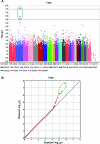Genome-wide association study of CSF biomarkers Abeta1-42, t-tau, and p-tau181p in the ADNI cohort
- PMID: 21123754
- PMCID: PMC3030225
- DOI: 10.1212/WNL.0b013e318204a397
Genome-wide association study of CSF biomarkers Abeta1-42, t-tau, and p-tau181p in the ADNI cohort
Abstract
Objectives: CSF levels of Aβ1-42, t-tau, and p-tau181p are potential early diagnostic markers for probable Alzheimer disease (AD). The influence of genetic variation on these markers has been investigated for candidate genes but not on a genome-wide basis. We report a genome-wide association study (GWAS) of CSF biomarkers (Aβ1-42, t-tau, p-tau181p, p-tau181p/Aβ1-42, and t-tau/Aβ1-42).
Methods: A total of 374 non-Hispanic Caucasian participants in the Alzheimer's Disease Neuroimaging Initiative cohort with quality-controlled CSF and genotype data were included in this analysis. The main effect of single nucleotide polymorphisms (SNPs) under an additive genetic model was assessed on each of 5 CSF biomarkers. The p values of all SNPs for each CSF biomarker were adjusted for multiple comparisons by the Bonferroni method. We focused on SNPs with corrected p<0.01 (uncorrected p<3.10×10(-8)) and secondarily examined SNPs with uncorrected p values less than 10(-5) to identify potential candidates.
Results: Four SNPs in the regions of the APOE, LOC100129500, TOMM40, and EPC2 genes reached genome-wide significance for associations with one or more CSF biomarkers. SNPs in CCDC134, ABCG2, SREBF2, and NFATC4, although not reaching genome-wide significance, were identified as potential candidates.
Conclusions: In addition to known candidate genes, APOE, TOMM40, and one hypothetical gene LOC100129500 partially overlapping APOE; one novel gene, EPC2, and several other interesting genes were associated with CSF biomarkers that are related to AD. These findings, especially the new EPC2 results, require replication in independent cohorts.
Figures



References
-
- Blennow K, Hampel H, Weiner M, Zetterberg H. Cerebrospinal fluid and plasma biomarkers in Alzheimer disease. Nat Rev Neurol 2010;6:131–144 - PubMed
Publication types
MeSH terms
Substances
Grants and funding
- K01 AG030514/AG/NIA NIH HHS/United States
- R01 AG022374/AG/NIA NIH HHS/United States
- R01 AG019771/AG/NIA NIH HHS/United States
- AG030514/AG/NIA NIH HHS/United States
- P30 AG010129/AG/NIA NIH HHS/United States
- P30 AG010133/AG/NIA NIH HHS/United States
- U24 AG021886/AG/NIA NIH HHS/United States
- AG024904/AG/NIA NIH HHS/United States
- R01 AG027342/AG/NIA NIH HHS/United States
- U01 AG024904/AG/NIA NIH HHS/United States
- U19 AG010483/AG/NIA NIH HHS/United States
- P30 AG019610/AG/NIA NIH HHS/United States
- AG010129/AG/NIA NIH HHS/United States
- AG032984/AG/NIA NIH HHS/United States
- R01 NS059873/NS/NINDS NIH HHS/United States
LinkOut - more resources
Full Text Sources
Medical
Miscellaneous
